Astronotus ocellatus
Oscar
SynonymsTop ↑
Lobotes ocellatus Agassiz, 1831; Cychla rubroocellata Jardine & Schomburgk, 1843; Acara compressus Cope, 1872; Acara hyposticta Cope, 1878; Astronotus ocellatus zebra Pellegrin, 1904; Astronotus orbiculatus Haseman, 1911
Etymology
Astronotus: from the Ancient Greek ἄστρον (astron), meaning ‘a celestial body’, and νότος (notos), which is normally said to mean ‘back’ but also appears to signify ‘south’.
ocellatus: from the Latin ocellatus, meaning ‘having small eyes’, in allusion to the distinctive spot on the caudal peduncle.
Classification
Order: Perciformes Family: Cichlidae
Distribution
Widely-distributed in the Amazon region and has been recorded in Colombia, Venezuela, Bolivia, Ecuador, Peru, Brazil, French Guiana, Paraguay, Uruguay and Argentina. Across this range it has been collected from numerous river systems, including the Ucayali, Solimões, Amazonas, Negro, Madeira, Tapajós, Tocantins, Orinoco, Approuague, and Oyapock. Feral populations also exist in several countries, including Singapore and the USA.
Wild fish are occasionally available in the trade, but the vast majority of those on sale originate from commercial breeders in Eastern Europe or the Far East.
Habitat
Most often found in the shallows of slow-moving or still waters in forested areas. It appears to favour silt-laden white water habitats, where it is typically associated with submerged tree roots or under cover of marginal vegetation.
Maximum Standard Length
250 – 350 mm.
Aquarium SizeTop ↑
An aquarium with base dimensions of 150 ∗ 60 cm is just about large enough to house a single adult with larger quarters required for a pair or group.
Maintenance
Unsuitable for the carefully-aquascaped aquarium since it has a tendency to dig into the substrate but otherwise relatively unfussy. A natural-style set-up could include a soft, sandy substrate, relatively dim lighting plus some large driftwood roots and branches.
Efficient filtration and a dedicated maintenance regime comprising weekly water changes of 30-50% aquarium volume are essential, and if possible the heaterstat should be situated externally as this species has been known to break such items of equipment.
Water Conditions
Temperature: 20 – 28 °C
pH: Captive-bred examples are not fussy with somewhere in the range 6.0 – 7.5 normally recommended. Wild-caught fish may require more specific conditions depending on origin.
Hardness: 90 – 357 ppm
Diet
This species is a generalised omnivore, feeding on a range of items including smaller fish, insects, crustaceans, zooplankton and various types of both terrestrial and aquatic vegetation in the wild, although meatier foods appear to be the preferred option with fruit and other plant material being taken when prey is scarce.
A study by Winemiller (1990) revealed that of the fish consumed, most were benthic catfish including Bunocephalus, Rineloricaria and Ochmacanthus species. Some populations have been oberved hunting in a similar fashion to the Nimbochromis of Lake Malawi, utilising a behavioural strategy known as thanatosis, or ‘playing dead’.
In the aquarium it is an unfussy feeder, although a high protein menu is preferable. A good quality cichlid pellet can be used as the staple diet, supplemented with regular offerings of live or frozen foods. Live earthworms are a particular favourite, but prawns, whitebait, river shrimp, crickets etc., are all useful alternatives.
Take care not to overfeed as oscars are notoriously greedy and soon learn to ‘beg’ for food whenever their owner approaches the aquarium.
Like the vast majority of predatory fishes this species should not be fed mammalian/avian meat such as beef heart or chicken, and similarly there is little benefit in the long-term use of ‘feeder’ fish such as livebearers or small goldfish which carry with them the risk of parasite or disease introduction and at any rate tend not have a high nutritional value unless properly conditioned beforehand.
Behaviour and CompatibilityTop ↑
Although not especially aggressive for a cichlid of this size this species’ predatory nature dictates that it should not be combined with much smaller fishes.
Its adult size also precludes the possibility of it being maintained in a community in all but the largest private aquaria.
Potential tankmates include characids, anostomids, other cichlids, and larger loricariid or doradid catfishes.
Sexual Dimorphism
In wild populations adult males are sometimes a little larger and more colourful than females, but this species does not tend to exhibit external sexual differences.
In nuptial females the ovipositor is visible as an extension to the oviduct just prior to and during spawning.
Reproduction
This species is a substrate-spawner developing extended pair bonds.
The best way to obtain a pair is to begin with a group of half-a-dozen or more youngsters which should begin to pair off naturally as they reach sexual maturity. Once a pair has formed the other fish should be removed.
The aquarium should contain a number of flat rocks or other structures in order to provide a choice of spawning sites.
During courtship the pair will select and then thoroughly clean their chosen site. The eggs themselves are white and opaque immediately post-laying. We failed to find any data confirming the exact reasons for this, but a viable brood will tyically change colour during the first 24 hours.
Parental care is extended post-hatching, but once the fry are free-swimming they can safely be separated from the adults.
Careful thought is required before attempting to breed this species, however. A single female can lay as many as 2000 eggs meaning considerable space and resources will be necessary if the intention is to raise them all. In addition, A. ocellatus is among those fishes most-often discarded after growing large with public aquaria and stores commonly offered more than they are able to house. It is also considered an invasive pest in some countries, and has little commercial value since it continues to be produced on a massive scale by ornamental breeders.
NotesTop ↑
This species is also referred to as ‘velvet cichlid’, ‘red oscar’, ‘tiger oscar’, or ‘marble cichlid’.
It is a popular aquarium fish although its adult size and typical life-span of 10-20 years must be taken into account before purchase. Numerous ornamental strains are now available, and while care is more-or-less identical for all of them a degree of additional care must be taken with the ‘long-finned’ variety which is a little less competitive than other forms.
A. ocellatus can be told apart from its only congener, A. crassipinnis, by presence (vs. absence) of ocellated spots at the base of the dorsal-fin, having the anteriormost light vertical body bar located above the anal-fin base (vs. anterior to the pectoral-fin tip), plus possession of 13 spinous and 20 soft (vs. 12 spinous and 21-22 soft) dorsal-fin rays. In addition, A. crassipinnis exhibits two dark vertical bars in place of the first light bar in A. ocellatus, and is overall darker in colour.
The taxonomy of the genus is far from resolved, however, with genetic analyses suggesting that a number of additional, morphologically cryptic species exist.
For example, the dorsal ocelli only appear to be present in western Amazonian populations, with only Peruvian A. ocellatus having been studied in depth.
The colour pattern in all Astronotus is cryptic and composed of irregularly-arranged blotches and stripes, while juveniles are typically black with white stripes.
In phylogenetic terms Astronotus has formerly been grouped in the putative tribe Chaetobranchini alongside the genera Chaetobranchus and Chaetobranchopsis due to morphological similarities between the three (Kullander, 1998), although recent analyses have tended to place it closer to the tribes Cichlini and Retroculini (López-Fernández et al., 2005), Cichlasomatini and Heroini (López-Fernández et al., 2010) or as sister to all these groups (Smith et al., 2008).
References
- Spix, J. B. von and L. Agassiz, 1829-1831 - Selecta Piscium Brasiliam: Part 1: i-xvi + i-ii + 1-82, Pls. 1-48;, Part 2: 83-138, Pls. 49-101
Selecta genera et species piscium quos in itinere per Brasiliam annos MDCCCXVII-MDCCCXX jussu et auspiciis Maximiliani Josephi I.... colleget et pingendso curavit Dr J. B. de Spix.... Monachii. - Kullander, S. O., 1986 - Swedish Museum of Natural History: 1-431
Cichlid fishes of the Amazon River drainage of Peru. - Kullander, S. O., 1998 - In: Malabarba, L. R. , R. E. Reis, R. P. Vari, Z. M. S. de Lucena and C. A. S. Lucena (eds). Phylogeny and classification of Neotropical fishes. Edipucrs, Porto Alegre: 1-603
A phylogeny and classification of the South American Cichlidae (Teleostei: Perciformes). Pp. 461-498 - Leo Smith, W., P. Chakrabarty, and J. S. Sparks, 2008 - Cladistics 24: 625-641
Phylogeny, taxonomy, and evolution of Neotropical cichlids (Teleostei: Cichlidae: Cichlinae). - López-Fernández, H., K. O. Winemiller, and R. L. Honeycutt, 2010 - Molecular Phylogenetics and Evolution 55: 1070-1086
Multilocus phylogeny and rapid radiations in Neotropical cichlid fishes (Perciformes: Cichlidae: Cichlinae). - López-Fernández, H., R. L. Honeycutt, M: L. J. Stiassny, and K. O. Winemiller,, 2005 - Zoologica Scripta 34: 627-651
Morphology, molecules, and character congruence in the phylogeny of South American geophagine cichlids (Perciformes: Cichlidae). - Reis, R. E., S. O. Kullander and C. J. Ferraris, Jr. (eds), 2003 - EDIPUCRS, Porto Alegre: i-xi + 1-729
Check list of the freshwater fishes of South and Central America. CLOFFSCA.
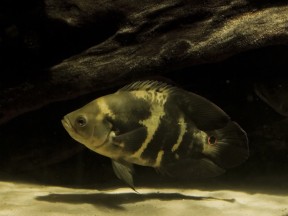
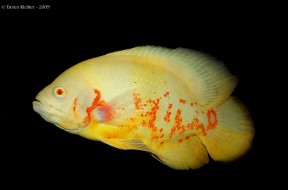
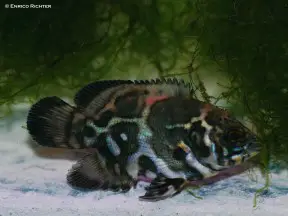
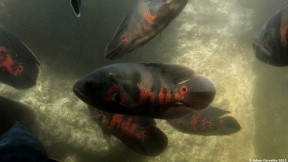
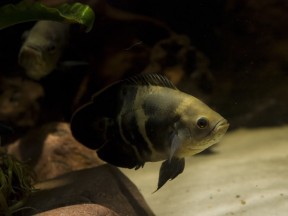
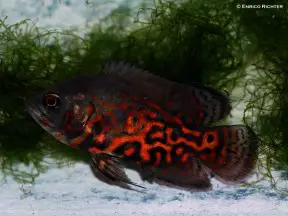

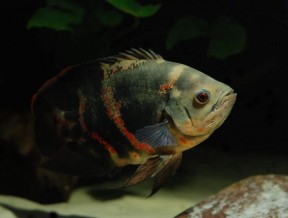
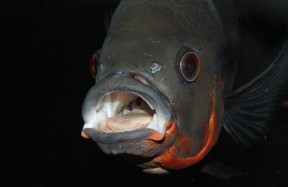
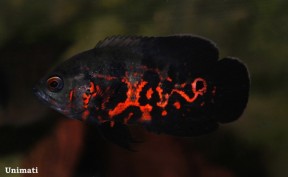
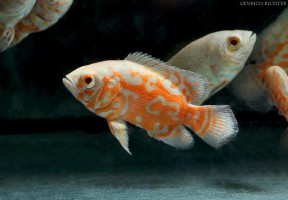
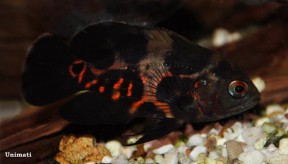

December 7th, 2013 at 4:03 pm
I would make a correction concerning suitable tank size for Astronomus Ocellatus. Considering Oscar grows 30-40 cm in captivity and it is pretty messy fish, the footprint of tank for this fish should be at least 150 cm for one specimen.
February 8th, 2014 at 5:01 pm
Noted and finally fixed, thanks for the feedback siksu.